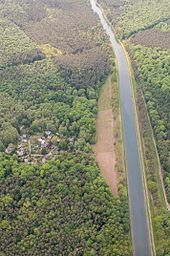Ragous dam
The Ragöser Damm is a canal dam of the Oder-Havel Canal (OHK 71.0 to 71.8) in the northeast of Eberswalde . With a top height of 28.6 meters, it is the highest canal embankment in Europe and at the time it was opened it was the highest in the world.
It is 800 meters long and was built in the course of the construction of the Oder-Havel Canal in 1907–1911 to compensate for the difference in altitude in the valley of the Ragöse . For the dam, 1 million cubic meters of soil was poured.
Approximately in the middle of the dam (OHK 71.6) is the passage of the Ragöse, which was completed in 1908. It has a mouth profile , a width of 4.20 meters and a height of 4.30 meters. The length was originally 156.30 meters. 38 concrete rings with different thicknesses depending on the height of the covering form the tube. At that time, even boat trips through the tunnel were permitted.
From March 1997 to December 1998 additional safety measures (so-called follow-up measures) were carried out on the dam after dam stretches of other federal waterways suffered damage and deficiencies were also found on the Ragöser dam. For this purpose, 2,473 sheet piling with lengths of 8.25 meters to 20.25 meters were pressed into the dam on both sides of the dam crest . They are supposed to direct seepage water downwards. Further water drainage devices were installed at the foot of the dam so that water can be fed into the ragöse if necessary.
Furthermore, approx. 16,000 cubic meters of soil were poured on the slope on the south side over a length of 400 meters. The Ragöse passage was extended to 176.90 meters by inserting 7.1 meters of a 27.7 meter long steel pipe into the passage.
Today the Ragöser Damm is a technical monument.
Web links
- Ragöser Damm at the Eberswalde Waterways and Shipping Office with pictures of the aftercare measures
Coordinates: 52 ° 51 ′ 31 ″ N , 13 ° 50 ′ 59 ″ E



